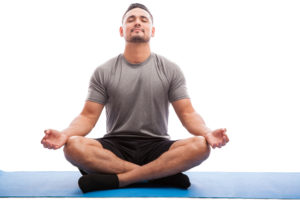Posture
The Anatomy of Functional Training Risks
Many clients can’t seem to get enough of workouts that meld functional movements with high-intensity resistance training. Indeed, workouts using dynamic, high-intensity, full-body movements are great for strength and health—provided the body functions properly and exercisers use correct technique.
Cultivate Joy Through Mindfulness
It’s a busy, technology-dominated world—and most of us are continually spinning, twisting and turning in an effort to “get things done” and “produce.” We work, we raise families, we have countless responsibilities. The truth is, this is distracted living, and it raises stress levels, lowers productivity and interferes with our ability to focus. When we live this way, we fail to cultivate a sense of contentment and joy.
Any Kind of Physical Activity Reduces Mortality Rates
Plenty of research encourages hitting the gym or going for a run as a means of keeping the grim reaper at bay. It turns out that any kind of physical activity—whether it’s achieved at the gym or at work—has protective benefits, according to a study produced by the Population Health Research Institute at McMaster University in Hamilton, Ontario.
Get Up, Stand Up—For Your Health
We know that sitting long hours is a health hazard that can lead to early death. What’s been unclear is whether frequent breaks in sit time can reduce that risk even if total sit time remains the same. Researchers from Columbia University Medical Center looked into that question.
Mindful or Mind Full?
It’s a busy, technology-dominated world—and most of us are continually spinning, twisting and turning in an effort to “get things done” and “produce.” We work, we raise families, we have countless responsibilities. The truth is, this is distracted living, and it raises stress levels, lowers productivity, interferes with our ability to focus and compromises the mind-body connection. When we live this way, we fail to cultivate a sense of contentment and joy, which is counterproductive to our work as fitness and wellness professionals.
Why Proper Rib-Cage Position Is Important
Proper thoracic-cage functioning sets the groundwork for healthy movement.
Conditioning for Kayaking
Did you know that 13 million people participated in some form of kayaking in 2014, making it one of the most popular flatwater sports (Outdoor Foundation 2015)? If you’re a kayaker, you know that the main challenges are building upper-body strength for paddling and maintaining a strong lower back to avoid back pain.
Preventing Golf Injuries
As a golfer, you want to stay injury-free to practice and compete regularly, which ultimately lets you hone your skills and elevate your performance.
To help avoid injury and boost level of play, you need to understand how two key muscle and soft-tissue systems—the posterior oblique system and the anterior oblique system—affect the golf swing.
Yoga and Tai Chi Offer Nondrug Pain Management
Complementary approaches like yoga, tai chi, acupuncture, massage therapy and relaxation techniques can help some people manage chronic pain, says a research review published in Mayo Clinic Proceedings (2016; 91 [9], 1292–1306). In the United States, chronic pain affects 126 million adults in any given year, with as many as 40 million of them suffering from severe pain. Leading disorders include back pain, joint pain, neck pain and headaches.
Skeletal Muscle Hypertrophy
Clients who want more muscularity need to face one of the most fundamental facts of skeletal muscle hypertrophy: Training to failure is crucial to building bigger muscles. Two original research studies reinforce this reality while offering meaningful new insights into hypertrophy training.
Menopause Symptoms: Can Yoga Help?
"Joanne," aged 51, presents with hot flashes and vaginal atrophy. She feels depressed, anxious, irritable, fatigued and not as confident in herself as she once was. Somehow she feels out of control. Her body is behaving unpredictably: She doesn't know when her next hot flash is coming or how to control the fat that is shifting up toward her waist.
Chronic Pain in Fitness Professionals
An Objective Eye
It can be difficult to take a step back and be objective when it comes to your own health. Katy Bowman, MS, director of the Restorative Exercise Institute in Ventura, California, and author
of Move Your DNA: Restore Your Health Through Natural Movement (Propriometrics Press 2014), suggests you write down
the following:
Fit to Travel
Whether we’re vacationing with our family or heading to the 2015 IDEA World Fitness ConventionTM with 12,000 other fitness enthusiasts, it can be challenging to stay fit when we’re on the road. Even the healthiest exercise professionals can get caught off-guard with aches, pains, stress and guilt that prevent us from having fun and functioning at our best.
If travel throws the fittest of us off track, imagine what it does to everyone else.
Excessive Thoracic Kyphosis: More Than Just Bad Posture
Excessive thoracic kyphosis (ETK) is a disproportionate forward rounding or curvature of the middle and upper back, also known as the thoracic spine (Kendall, McCreary & Provance 2005). ETK is an extremely common musculoskeletal imbalance brought on by prolonged time in some postural positions; exercise and/or activity choices; environmental factors; myofascial dysfunction; intolerances to food and/or other allergic reactions; and psychological stress.
“What is the most effective posture tip you give clients?”
This is the tip I give clients: Picture a string pulling your head up toward the ceiling. This helps to create space between the vertebrae; when you relax, the spinal segments can then realign.
My favorite way to teach proper pos- ture is to have people close their eyes and slowly tip their spine forward and back and side to side to find their true “good posture.”
Everyone’s spine is slightly different, and mirrors can only get us so far. Real posture is found within each person through body awareness.
Practice Techniques For Pilates Instructors To Emphasize
Michele Olson, PhD, FACSM, professor of exercise science at Auburn University in Montgomery, Alabama, and Cherie Wells, lecturer in physiotherapy and clinical education coordinator at the University of Western Sydney in Penrith, Australia, both lead investigators of multiple Pilates studies, offer the following research-based practical tips on what mind-body fitness professionals should emphasize to maximize Pilates benefits for clients:
Pilates Exercises Improve Back Health
Many clients come to you with low-back pain, a condition that affects 80% of Americans. In contrast, chronic low-back pain—defined as persistent pain and disability lasting longer than 3 months—affects approximately 2%-8% of Americans.
Excessive Thoracic Kyphosis: Much More Than Just Bad Posture
Excessive thoracic kyphosis is a disproportionate forward rounding or curvature of the middle and upper back, also known as the thoracic spine (Kendall, McCreary & Provance 2005). ETK is an extremely common musculoskeletal imbalance brought on by prolonged time in some postural positions; exercise and/or activity choices; environmental factors; myofascial dysfunction; intolerances to food and/or other allergic reactions; and psychological stress.
Diaphragmatic Breathing & Neck Pain
Everyone from elite athletes to average clients can benefit from learning more about breathing or reprogramming the way they breathe. More specifically, by teaching them techniques that emphasize diaphragmatic breathing, you will help them meet their exercise goals.
A Pilates Approach to Posture and Alignment
Assessing clients’ posture or alignment can sometimes be overwhelming for both novice and experienced Pilates instructors. Even with all our knowledge of anatomy, kinesiology, movement and injuries, it can be hard to know where to start.
- « Previous
- 1
- 2
- 3
- Next »

















